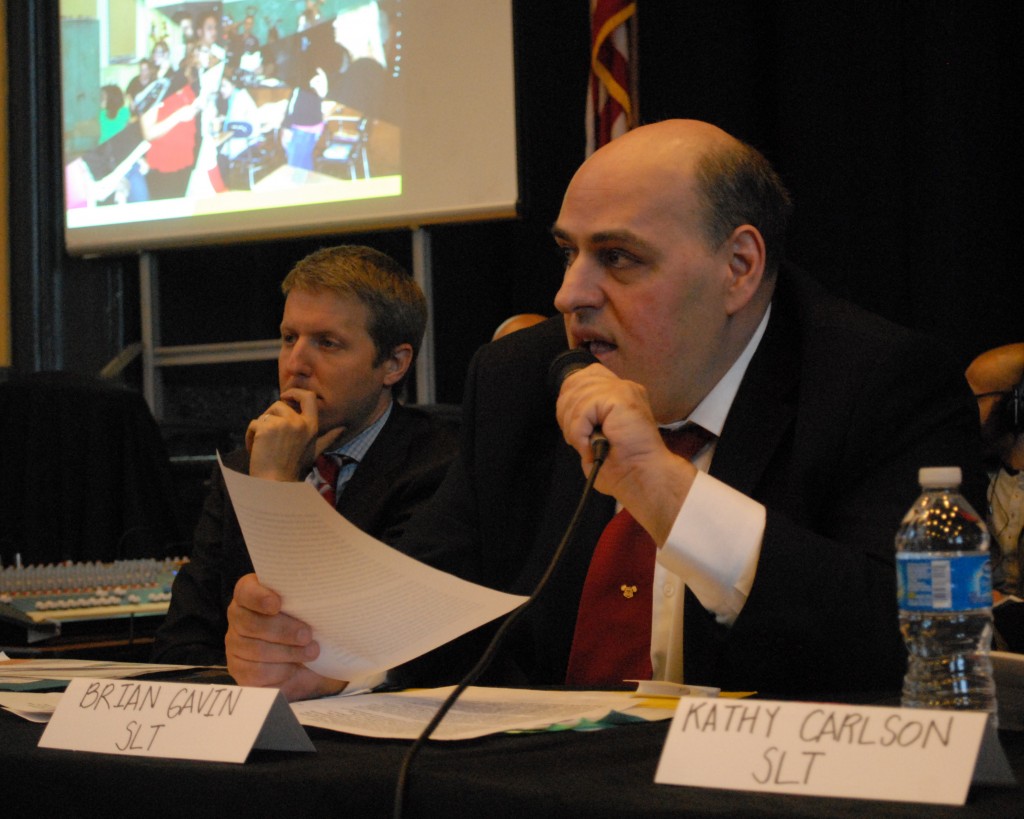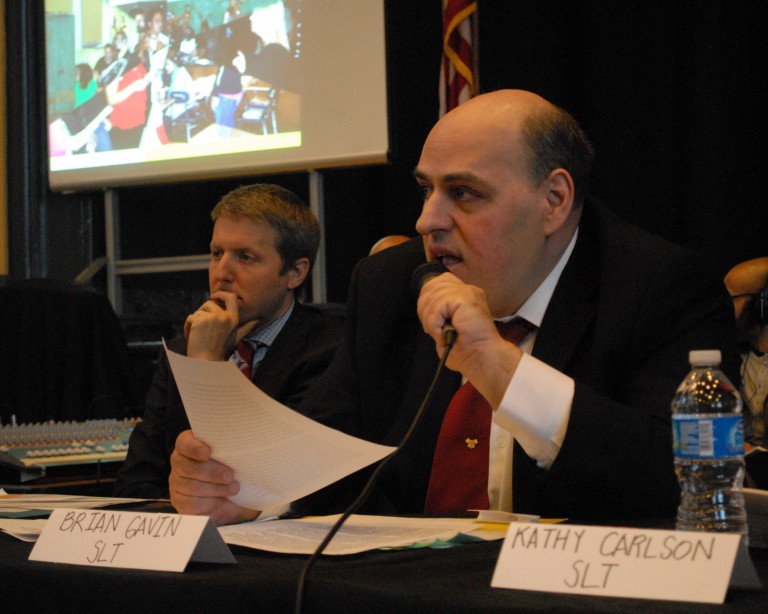
Brian Gavin, chairperson of Grover Cleveland’s School Leadership Team, detailed how parents, students and teachers don’t want the DOE’s planned intervention. To the left, Deputy Chancellor Mark Sternberg was the only DOE representative at the meeting. He sat through dozens of vehement testimonials aimed at his department and Mayor Michael Bloomberg. Forum Newsgroup photo by Jeremiah Dobruck.
Grover Cleveland High School got a glimpse of hope that they might be able to save their school Monday, and during a public hearing in the school’s auditorium that night, it showed.
That day, the Department of Education (DOE) announced it was taking seven schools off the list of those scheduled to be closed and reopened under the turnaround plan.
Grover Cleveland remained one of 26 that would replace their names and half their teachers under the plan, but the announcement renewed the fervor to fight for Cleveland.
“Closing Grover Cleveland High School and replacing its staff represents an extreme error in judgment,” said Brett Green, a 15-year teaching veteran of the school’s music program. “If you maintain your current course of action, you will be making a big mistake. Do not make a big mistake; do not close Grover Cleveland High School.
Green’s testimony was one of dozens that drew repeated cheers and ovations from a mostly-full auditorium. Conversely, any mention of Mayor Michael Bloomberg and the DOE drew boos and heckling. Officials said 70 people signed up to speak.
The DOE said on Monday that it removed the seven schools because they received As and Bs in the DOE’s latest ratings. Grover Cleveland received a C.
Grover Cleveland officials are convinced the school is making progress though.
Brian Gavin, chairperson of Grover Cleveland’s School Leadership Team, sat on the dais and offered a spirited defense of the school by laying out its achievements.
He listed a bevy of rare sports, college-level courses and certifications his school offers and hit highlights such as being one of five schools nationwide to partner with technology company Lenovo in an app-building and job training program.
He said replacing half of the school’s teachers would undo carefully crafted education communities that are already reforming the school.
“Instead of providing help, it puts us back to square one.” Gavin said. “The last thing Grover Cleveland needs is more radical change.”
A parade of students and teachers spoke at the public hearing, but before they got to the microphone, half a dozen politicians or their representatives took the time to blast the plan.
Loudest among them was Assemblywoman Catherine Nolan, a graduate of Grover Cleveland.
“I want to say to the people from the Department of Education who came from Manhattan, you have awoken Ridgewood,” she said. “This terrible threat to our community high school has been met, I think, with the strongest outpouring of support in my many years of community service.”
Nolan, chair of the assembly’s education committee, was a sponsor of the plan that instigated this process. She supported the School Improvement Grants the city is now clawing for.
Grover Cleveland was scheduled to get part of a $60 million grant for 33 struggling schools. To get the money, the schools had to implement one of four improvement plans.
Turnaround is one of the more drastic plans, requiring closing the school and reopening it under a new name with 50 percent of the staff changed—but 100 percent of the same students.
“I did not sponsor this so my high school could be closed,” Nolan shouted, rallying the crowd.
The DOE originally implemented a softer plan—the restart model—which didn’t include teacher turnover.
But the state then tied the grant money to the city implementing teacher evaluations. When the teachers union and Mayor Michael Bloomberg couldn’t reach an agreement on a system, Bloomberg announced he would implement the turnaround plan.
He argued it’s a de-facto form of teacher evaluations that would ensure the schools got the grant money.
The decision has made him and the DOE the target of plenty of rage.
The dais at the hearing, however, included nobody with actual decisions-making power.
There was one representative from the DOE, Deputy Chancellor Mark Sternberg.
He warned before testimony started in earnest that the hearing was not a decision point and the Panel for Educational Policy would vote on the plan on April 26.
The Queens representative from the PEP, Dmytro Fedkowskyj, encouraged attendees to swarm that meeting, but they know it’s a grim prospect.
The 13-member panel includes eight mayoral appointees and only five appointed form the boroughs. The eight often side with the mayor’s policy.
“We teach our students that democracy works, that when the people have a mandate, the elected officials have to listen. Everybody here has said Grover Cleveland should stay open,” history teacher Donald Zigler said while looking directly at Sternberg. “It’s a disgrace that you want to do something different.”
Six other schools in Queens are included in the turnaround plan: Flushing High School; Long Island City High School; William Cullen Bryant High School, also in Long Island City; Newtown High School in Elmhurst; August Martin High School in Jamaica; Richmond Hill High School; and John Adams High School in Ozone Park.
They will also hold public hearings leading up to the April 26 vote. The PEP’s determinate meeting will start at 6 p.m. at Prospect Heights High School at 883 Classon Ave. in Brooklyn.
By Jeremiah Dobruck
j.dobruck@theforumnewsgroup.com

